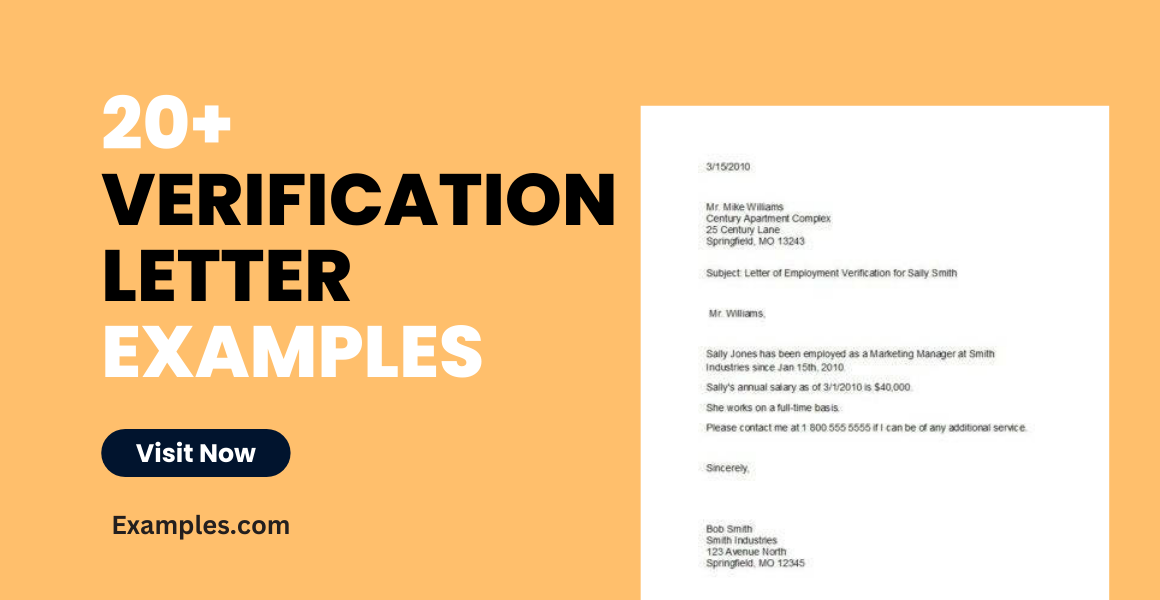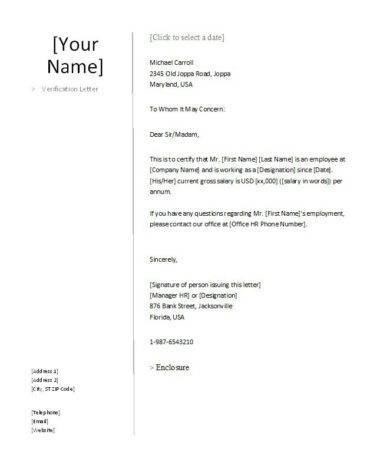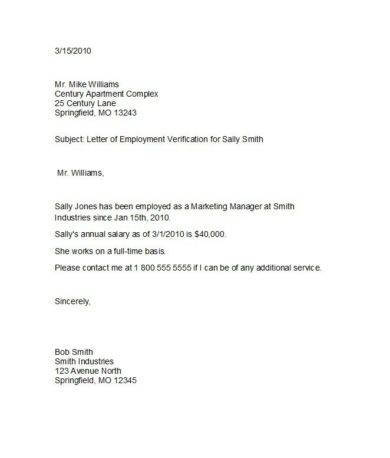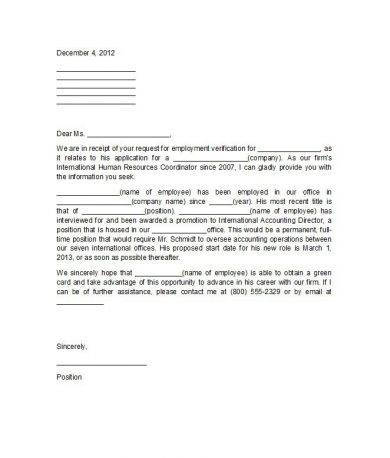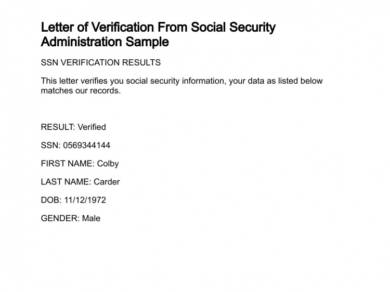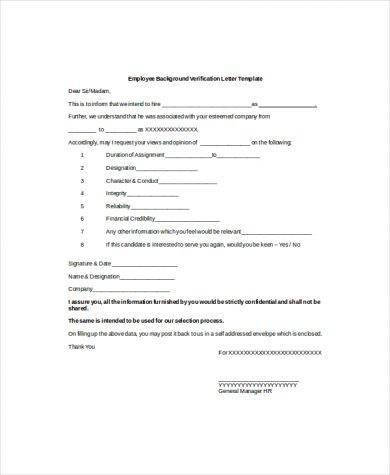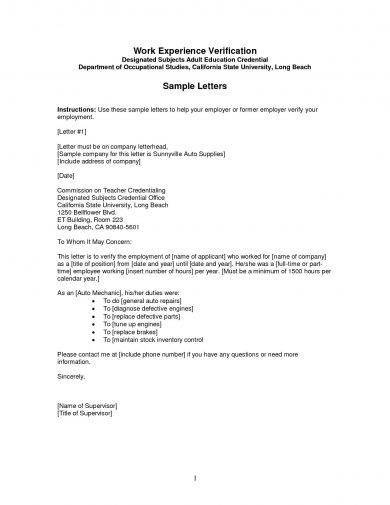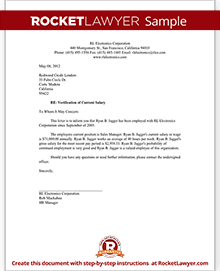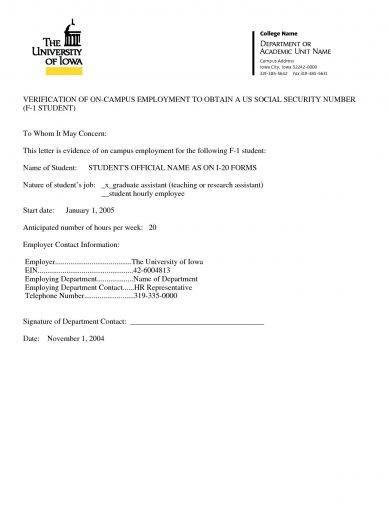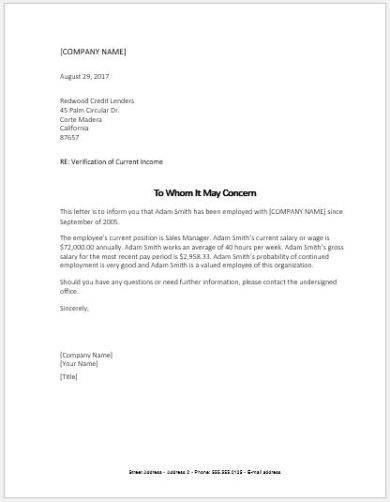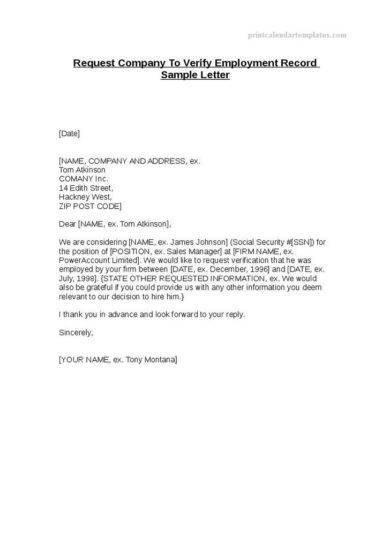20+ Verification Letter Examples to Download
Formal letters are the most reliable form of business communication because it allows the writer to take the time to gather his thoughts and eloquently put them into writing. It is also a very effective method of impressing upon the recipient your authority and credibility as a business owner or company staff.
Income Verification Letter for Self Employed Template
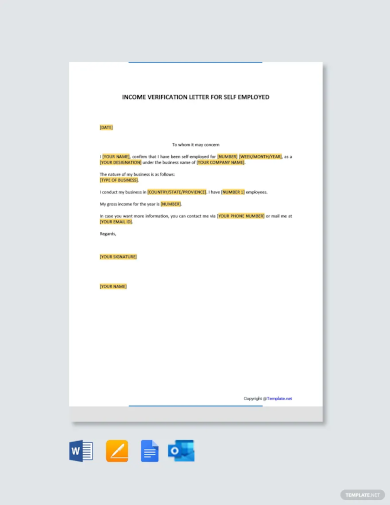
Employment Verification Letter With Salary Template
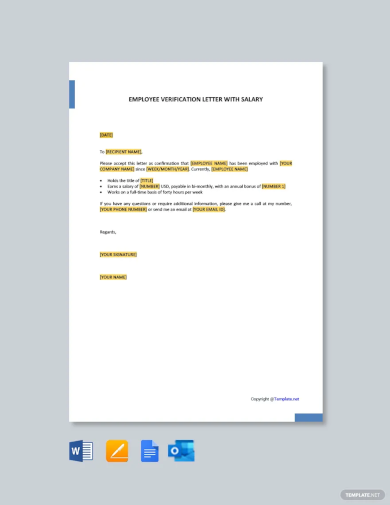
Employment Verification Letter Template
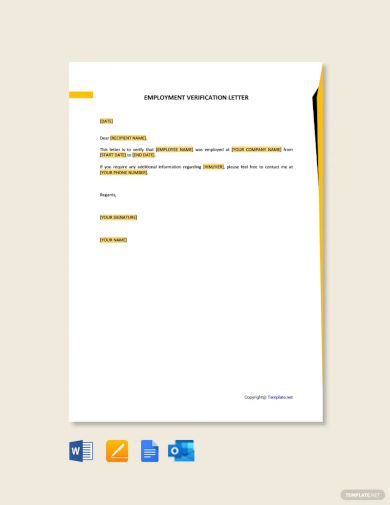
Income Verification Letter Template
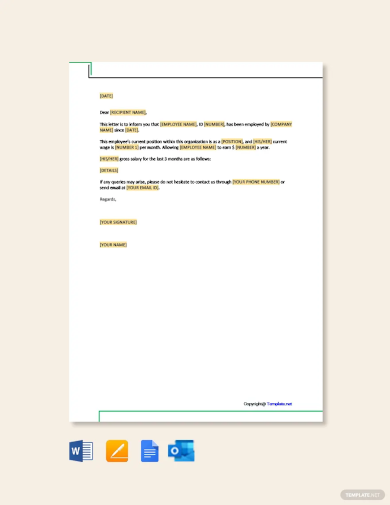
Employment Verification Letter for Affidavit of Support Template
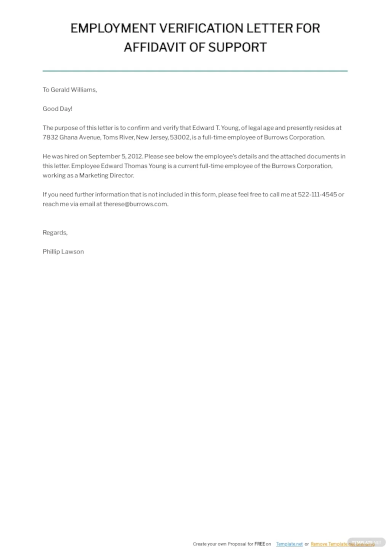
Free Salary Verification Letter for Proof of Income Template

Free Restaurant Employee Verification Letter Template
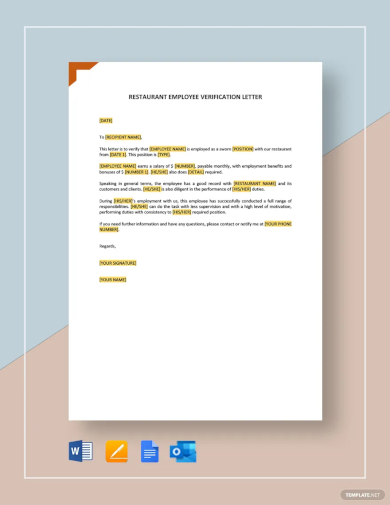
Employment Verification Letterhead Template

Employment Verification Template for Current Employee
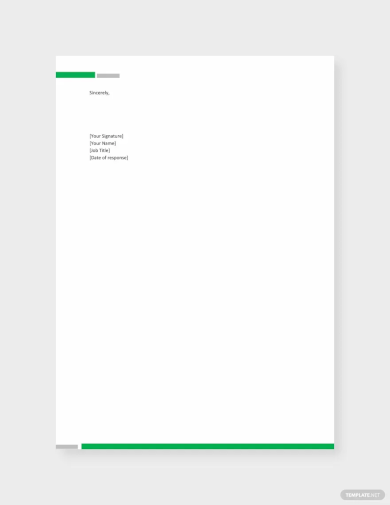
Verification of Employment and Letter of Recommendation Example

Proof of Employment Letters
Verification Letter Sample Document
A business letter is also written in a formal language, utilizing a writing style that follows more rigid rules. These elements are necessary to give a business letter the atmosphere that is necessary for a medium used for a significant correspondence.
There are a variety of types of letters, depending on the purpose for writing them and their recipient. Here are some reasons why letter writing is still important in the corporate world:
1. Letters serve as a documentation.
In the business world, documentation is one of the most important offensive and defensive strategy in case a conflict brews. Since professional letters are usually written on a personalized stationery unique to the company, and with the sender’s handwritten signature at the bottom of it, it can provide a paper trail that is much harder to disregard when used as evidence.
2. Letters are more classy and professional.
Instead of sending the ubiquitous, impersonal email, letters are better at expressing your transaction’s purpose, and the emotions you want to convey along with it. Letters are more sincere, with a more attention-demanding nature. When your recipient receives your letter through the mail, it will pique his curiosity and interest to know what’s inside. This unobtrusive technique has already gained you an audience. You may also see application letter examples.
3. Letters are better at holding a more serious issue or problem.
There will come a time in your business’s existence that you will have to communicate a problem or proposal within the members of your organization or to an external party that an electronic message simply cannot express because it would be too impersonal and insincere that way. In cases like this, you can only rely to a formal business letter to do the job for you. Your letter can be snail mailed, faxed, or expedited depending on its urgency.
Letter of Verification Sample
Fillable Verification Letter Sample
Letter of Verification from Social Security Administration
Parts of a Business Letter
1. Letterhead
This part will provide all of the organization’s important details. Usually, they would use printed paper where their information is stated on top of the paper. You may also see notice letter examples.
2. The date of the letter upon writing
The month of writing should be spelled out and not abbreviated. The year’s complete four numbers should also be specified.
3. The inside address
The address of your recipient should be provided after your own.
4. The greeting
Also known as the salutation, this part will highly depend on your relationship with the recipient. If you are more friends than mere business colleagues, your greeting can be warmer and more personal. Otherwise, it should be formal and direct. You may also like business reference letter examples.
5. The subject line
This aspect is optional, however, when it is written, it usually holds a brief overview of the letter’s main contents so as to give the recipient a general idea on what it holds.
6. The body paragraphs
The body is the main part of all types of letters, business, and otherwise. This is where you will have to explain the purpose of your letter. This is also where you will include a detailed discussion of the matters you wish to elaborate upon the letter’s receiver. Your body paragraphs should be eloquent yet prominently concise since this is a business letter you are writing. Get to the point and provide the information you need to communicate. You may also check out business proposal letter examples.
7. The complimentary close
As a general letter writing rule, your letter must always end with this short and polite closing.
8. Signatures and writer’s identification information.
You should sign your letter with your first and last names. You may also include a second line for your job position or title if necessary.
Employment Verification Letter Template
Work Experience Verification Sample
Thorough Verification Letter Example
What Is a Verification Letter?
A verification letter, or an employment verification letter, is another type of business letter that is written as a response to the request and inquiry of a prospective employer, a government agency, or another third party, such as a bank, who needs proof that an individual is or was employed by the organization. Predominantly, the request would want to verify the date of employment and salary information of the person.
For verification letters requested by prospective employers, information about the individual’s work performance and potential rehiring is often asked. It is also typical to request the employee’s past job responsibilities and title and salary history. It is often up to the employer to limit the amount of information to release. After all, the details regarding the company employees’s duties and tasks is often a matter of privacy that must not be communicated to an outside entity.
The company, then, must have a consistent employment verification policy that needs to be observed for every verification request. The managers and staff, especially under the Human Resources department, must be trained on how to properly and prudently respond to verification requests. Particularly with prospective employers who may asked lengthy information about your previous employer, the details divulged must be finite.
Other parties, such as banks and other government agencies, who may ask you for a simple verification letter do not need as lengthy and as specific data as that which is required by future employers. They would often be content with receiving a simple confirmation from you.
Banks, for example, might ask for an employment verification to help them decide about granting a house or car loan. They would need information about the individual’s date of employment and salary. Most verification letters will come from prospective employers and banks or loaning agencies. You may also see complaint letter examples.
Tips in Writing an Employment Verification Letter
If you happen to be in the position of providing a verification letter for a former or current employee, here are the principal information and general guidelines to remember to make your letter professional and thoroughly written:
1. Use a neat stationery, preferably one that has your logo on it.
Having a stationery that your company can use for these transactions standardizes the process. It can also add integrity and professionalism to your letter if it holds your company’s symbol. You may also see how to write a verification letter examples.
2. Notify an employee about the verification request about him.
This is important to make sure that the request is from a bona fide organization and not just a hoax. The employee’s authorization is also necessary, both as a courtesy and as a company policy, for you to be able to disclose any information about him to the party asking for it. Besides, if the request is truly in the knowledge of the employee, he can provide you with the information you will need to provide in the letter, depending on the purpose it will serve.
3. When writing the letter, follow the business writing format.
This is the style that is highly suggested when corresponding professionally and formally because it will give your letter a more authorized appearance. Include your contact information on top of the letter, the date of writing, and the recipient’s full contact information if you have it. A salutation at the beginning and at the end of the formal letter is also required. Your handwritten signature should also be provided.
4. Be concise with your writing.
Employment verification letters should not be lengthy. Only provide the information you need to discuss with the letter’s recipient.
You don’t have to discuss the employee’s work performance, or give a detailed story of his great work ethics. Perhaps an overview of the employee’s role in the company can be included but refrain from going into details. Your letter’s purpose is only to verify the party’s employment, so details that can’t help with that motive must be avoided. You may also like signature verification letter examples.
5. Include all of the information requested.
To make your letter effectual, the necessary information asked from you must be provided. This usually includes the employee’s name, the company department they worked under, and, sometimes, their job title must be specified as well. However, you may also be asked about the employee’s salary, how often he receives it in a month, and how many hours they work in a day. But if you weren’t asked to provide these details, avoid doing so. You may also check out income verification letter examples.
The employee for whom the letter is written should provide the information you need to include in your letter.
6. Provide your contact information.
By the end of your letter’s body, it is best to add a few additional sentences expressing your willingness to be contacted if the letter’s recipient has any further questions about the employee. You should also include your contact information so that they can reach you easily. Doing so will also add credibility to your letter since it’s harder to fake a verification letter if the contact details of a superior are written on it. You might be interested in employee verification letter examples.
7. Proofread the letter before you send it.
A verification letter must be valuable to your employee since he asked for it. He might need it for a loan, or an insurance, or another job, which means that you must do your part in making the letter as professional as possible. Read the letter meticulously before sending it to make sure that you have not committed any errors in writing. You may also see verification of employment letter examples.
On-Campus Employment Verification Letter
Income Verification Letter Sample
Request for Verification Letter Sample
How to Request for an Employment Verification Letter?
If you are asking for an employment verification letter from a former or a current employee, you must do so in a professional manner. Since you can’t create the letter for yourself, you would have to approach the Human Resources department in the company. Some companies may have policies about providing these types of information to a third party, which means that you will have to give permission for your employment data to be released. You may also see reference letter examples.
As for the letter itself, oftentimes, it is the Human Resources who will create the letter for you. But there are also instances where they will provide a template to be completed by the office manager you were held under. You can also go directly to your manager and provide the template or sample letter yourself. You may also like salary verification letter examples.
Make sure that you supply all of the important information that your manager may need to write the letter, including its recipient and other important details about your employment that they would have to highlight.
What Are the Things to Not Include in Your Verification Letter?
There must be limitations that are set when it comes to sharing data about a previous or current employee to an external organization. This must be observed to ensure and maintain privacy and security regarding the private businesses of the company. You may also see simple authorization letter examples.
Since verification letters cannot be avoided, here are a few of the things that you must avoid speaking about or including in your letter:
- Refrain from communicating any information without the consent of the employee who will be directly affected by the transaction. Usually, it is the employee who will bring the request to you. Otherwise, it is best to ask for his assent first. You may also like reference letter for employee examples.
- Do not provide any financial information unless it is requested.
- Do not provide any information that must be protected, or that which is unnecessary to the letter’s main purpose for being written, such as the individual’s marital status or health concerns.
- Do not provide any confidential information about the employee, such as him failing a drug test.
- Do not share any reasons why you would choose not to hire the individual again, or anything that may imply his poor work performance. You may also check out character reference letter examples.
- Do not provide any of your opinions about the individual, as a person and as an employee.
- Do not state anything that may harm the credibility or image of the person.
- Do not provide any information that may put you and your business at the risk of retaliation if ever the individual is not accepted in the job he is applying for, or the loan he has applied for. You might be interested in acceptance letter examples.
- As a general rule, do not state anything negative since it may be used for legal discovery in the future, which will not bode well for your company.
As an employer, it is your job to assist your current or previous employees achieve new jobs and be granted loans, even if it is through something as commonplace as a verification letter. However, do it in a way that will not jeopardize you or the organization you are a part of. You may also see what is an application letter.
Basically, the most important thing to remember when writing one is only to provide the information requested that will not be a breach of the company’s verification policy. Providing information more than that is no longer your task.


